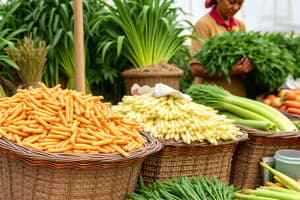Podcast
Questions and Answers
What is the speaker's intention in providing the list of economic concepts to be discussed?
What is the speaker's intention in providing the list of economic concepts to be discussed?
- To highlight the challenges faced by U.S. farmers in the global market
- To illustrate the diverse range of topics that will be addressed during the discussion
- To demonstrate the complexity of international trade
- To emphasize the importance of understanding specific concepts for improving standards of living (correct)
What is the speaker's primary goal in the discussion?
What is the speaker's primary goal in the discussion?
- To analyze the impact of international trade on the economic well-being of U.S. citizens and farmers. (correct)
- To promote the implementation of uniform trade requirements for all partners.
- To argue in favor of increasing U.S. agricultural exports
- To explore the relationship between trade and the competitiveness of U.S. agricultural products in global markets.
What evidence does the speaker provide to support the claim that trade in agricultural commodities is important to the U.S. economy?
What evidence does the speaker provide to support the claim that trade in agricultural commodities is important to the U.S. economy?
- The speaker emphasizes the concept of comparative advantage.
- The speaker highlights the role of the GATT negotiations and the WTO.
- The speaker does not provide specific evidence, instead relying on general statements about the importance of trade. (correct)
- The speaker mentions the importance of uniform requirements for trading partners.
What does the speaker suggest is a key determinant of the U.S.'s competitiveness in the world market?
What does the speaker suggest is a key determinant of the U.S.'s competitiveness in the world market?
What is the speaker's perspective on the importance of trade in agricultural commodities for the U.S. economy?
What is the speaker's perspective on the importance of trade in agricultural commodities for the U.S. economy?
What does the speaker imply about the relationship between trade and standards of living?
What does the speaker imply about the relationship between trade and standards of living?
What is the speaker's primary focus in discussing the GATT negotiations and the World Trade Organization (WTO)?
What is the speaker's primary focus in discussing the GATT negotiations and the World Trade Organization (WTO)?
What is the potential implication of increased utilization of production through trade, as mentioned by the speaker?
What is the potential implication of increased utilization of production through trade, as mentioned by the speaker?
What is a primary reason countries, including the U.S., are willing to sacrifice the benefits of trade?
What is a primary reason countries, including the U.S., are willing to sacrifice the benefits of trade?
What is an example of a U.S. policy designed to ensure self-sufficiency by protecting domestic industries?
What is an example of a U.S. policy designed to ensure self-sufficiency by protecting domestic industries?
Why is the U.S. sugar industry a strong example of a sector that benefits from trade barriers?
Why is the U.S. sugar industry a strong example of a sector that benefits from trade barriers?
How does the example of the U.S. sheep industry demonstrate the fear of shortages?
How does the example of the U.S. sheep industry demonstrate the fear of shortages?
What is a potential economic consequence of imposing protective tariffs or quotas on imported goods?
What is a potential economic consequence of imposing protective tariffs or quotas on imported goods?
What is the main argument used by advocates of protective tariffs and quotas to support their position?
What is the main argument used by advocates of protective tariffs and quotas to support their position?
Why is the U.S. auto industry an example of a sector that has received government subsidies to prevent its collapse?
Why is the U.S. auto industry an example of a sector that has received government subsidies to prevent its collapse?
What is the main theme explored in the provided content regarding trade and economic policies?
What is the main theme explored in the provided content regarding trade and economic policies?
What is the primary purpose of Mr. Brown's discussion on international trade?
What is the primary purpose of Mr. Brown's discussion on international trade?
Which of the following is a reason for the trade of fresh fruits and vegetables?
Which of the following is a reason for the trade of fresh fruits and vegetables?
What outcome is NOT supported by the discussion of trade efficiency?
What outcome is NOT supported by the discussion of trade efficiency?
During which season do Southern Hemisphere countries primarily export to the United States?
During which season do Southern Hemisphere countries primarily export to the United States?
Which industries are mentioned as having significant trade performance?
Which industries are mentioned as having significant trade performance?
What is a likely advantage of trade mentioned in the content?
What is a likely advantage of trade mentioned in the content?
What percentage of poultry is imported by the USA from Brazil, according to the poultry trade data?
What percentage of poultry is imported by the USA from Brazil, according to the poultry trade data?
Which factor is NOT mentioned as influencing the direction of goods and services in trade?
Which factor is NOT mentioned as influencing the direction of goods and services in trade?
What conclusion does Jeremy arrive at regarding world trade in pork?
What conclusion does Jeremy arrive at regarding world trade in pork?
What factor contributes to the price variability of pork loins in the U.S. market?
What factor contributes to the price variability of pork loins in the U.S. market?
What misconception might producers have about the short-run price boosts in hog prices?
What misconception might producers have about the short-run price boosts in hog prices?
How can the world market affect U.S. pork producers?
How can the world market affect U.S. pork producers?
What happens when exports of pork are above long-term average levels?
What happens when exports of pork are above long-term average levels?
Why is it expensive to ship fresh, chilled meats overseas?
Why is it expensive to ship fresh, chilled meats overseas?
What can result from short-run competition in pork availability?
What can result from short-run competition in pork availability?
What is a possible consequence of a significant purchase of pork by a foreign market?
What is a possible consequence of a significant purchase of pork by a foreign market?
What was the main focus of the first three GATT rounds?
What was the main focus of the first three GATT rounds?
What issue became prominent in the GATT discussions during the 1950s?
What issue became prominent in the GATT discussions during the 1950s?
Which GATT round focused specifically on agricultural products?
Which GATT round focused specifically on agricultural products?
What has been identified as a major barrier to free trade in agriculture according to the GATT discussions?
What has been identified as a major barrier to free trade in agriculture according to the GATT discussions?
What is the main conflict blocking progress in GATT negotiations?
What is the main conflict blocking progress in GATT negotiations?
What did Mr. Brown indicate as the most recent round of GATT?
What did Mr. Brown indicate as the most recent round of GATT?
What aspect of agricultural trade has been highlighted throughout the GATT negotiations?
What aspect of agricultural trade has been highlighted throughout the GATT negotiations?
What has been the effect of complex farm programs on trade, according to the discussions?
What has been the effect of complex farm programs on trade, according to the discussions?
What effect do subsidies have on foreign goods in the Canadian interior?
What effect do subsidies have on foreign goods in the Canadian interior?
What complicates trade for newly developing countries?
What complicates trade for newly developing countries?
What is a significant concern for U.S. industries regarding trade?
What is a significant concern for U.S. industries regarding trade?
What must be included in the elimination of barriers to trade for it to be considered fair?
What must be included in the elimination of barriers to trade for it to be considered fair?
How does the concept of 'fair trade' differ from 'free trade'?
How does the concept of 'fair trade' differ from 'free trade'?
What determines how the losers of trade deals are managed?
What determines how the losers of trade deals are managed?
What additional requirement is emphasized regarding trade regulations for it to be effective?
What additional requirement is emphasized regarding trade regulations for it to be effective?
What is one potential outcome of removing all trade barriers?
What is one potential outcome of removing all trade barriers?
Flashcards
Comparative Advantage
Comparative Advantage
The principle that countries should focus on producing goods and services where they have a comparative advantage, leading to higher overall output and economic well-being.
Absolute Advantage
Absolute Advantage
The ability of one country to produce a good or service at a lower cost than another country.
GATT (General Agreement on Tariffs and Trade)
GATT (General Agreement on Tariffs and Trade)
The General Agreement on Tariffs and Trade (GATT) was a multilateral agreement regulating international trade. It was signed in 1947 and lasted until 1995, when it was replaced by the World Trade Organization (WTO). The goal of the agreement was to reduce tariffs and other trade barriers. The GATT was created in the aftermath of World War II to reduce the barriers to international trade and thereby increase global trade and economic activity.
World Trade Organization (WTO)
World Trade Organization (WTO)
Signup and view all the flashcards
International Trade
International Trade
Signup and view all the flashcards
Utilization of Production
Utilization of Production
Signup and view all the flashcards
Fair Trade
Fair Trade
Signup and view all the flashcards
Determinants of Competitiveness
Determinants of Competitiveness
Signup and view all the flashcards
Importance of Pork Trade to the U.S.
Importance of Pork Trade to the U.S.
Signup and view all the flashcards
Transportation Costs and Export Cuts
Transportation Costs and Export Cuts
Signup and view all the flashcards
Impact of International Demand on U.S. Prices
Impact of International Demand on U.S. Prices
Signup and view all the flashcards
Temporary Price Surges
Temporary Price Surges
Signup and view all the flashcards
Price Risk and Uncertainty
Price Risk and Uncertainty
Signup and view all the flashcards
Producers' Long-Term Planning
Producers' Long-Term Planning
Signup and view all the flashcards
Impact of International Trade on Market Prices
Impact of International Trade on Market Prices
Signup and view all the flashcards
Price Variability in the U.S. Pork Industry
Price Variability in the U.S. Pork Industry
Signup and view all the flashcards
International Trade Flow
International Trade Flow
Signup and view all the flashcards
Government Intervention in Trade
Government Intervention in Trade
Signup and view all the flashcards
Seasonality of Production
Seasonality of Production
Signup and view all the flashcards
Production Cost Advantage
Production Cost Advantage
Signup and view all the flashcards
Economic Interdependence
Economic Interdependence
Signup and view all the flashcards
Protectionist Policies
Protectionist Policies
Signup and view all the flashcards
Imports
Imports
Signup and view all the flashcards
Fear of Shortages
Fear of Shortages
Signup and view all the flashcards
Price Support Programs
Price Support Programs
Signup and view all the flashcards
Economic Turmoil Argument
Economic Turmoil Argument
Signup and view all the flashcards
Protectionism's Economic Impact
Protectionism's Economic Impact
Signup and view all the flashcards
Protective Tariffs
Protective Tariffs
Signup and view all the flashcards
Quantity Quotas
Quantity Quotas
Signup and view all the flashcards
National Security Argument
National Security Argument
Signup and view all the flashcards
What are the major barriers to free trade?
What are the major barriers to free trade?
Signup and view all the flashcards
What is comparative advantage?
What is comparative advantage?
Signup and view all the flashcards
What is fair trade?
What is fair trade?
Signup and view all the flashcards
What are some examples of 'non-price' barriers to trade?
What are some examples of 'non-price' barriers to trade?
Signup and view all the flashcards
Why is removing trade barriers alone not enough to guarantee fair trade?
Why is removing trade barriers alone not enough to guarantee fair trade?
Signup and view all the flashcards
What are 'science-based rules and regulations' in international trade?
What are 'science-based rules and regulations' in international trade?
Signup and view all the flashcards
What are subsidies?
What are subsidies?
Signup and view all the flashcards
What are quotas?
What are quotas?
Signup and view all the flashcards
Early GATT Rounds & Agriculture
Early GATT Rounds & Agriculture
Signup and view all the flashcards
GATT's Turn to Agriculture
GATT's Turn to Agriculture
Signup and view all the flashcards
Domestic Farm Programs & Free Trade
Domestic Farm Programs & Free Trade
Signup and view all the flashcards
EEC's Complex System & Trade Conflicts
EEC's Complex System & Trade Conflicts
Signup and view all the flashcards
Uruguay Round & Domestic Policies
Uruguay Round & Domestic Policies
Signup and view all the flashcards
Early GATT Focus
Early GATT Focus
Signup and view all the flashcards
U.S. vs. EEC on Agricultural Trade
U.S. vs. EEC on Agricultural Trade
Signup and view all the flashcards
Domestic Policies & International Trade
Domestic Policies & International Trade
Signup and view all the flashcards
Study Notes
Introduction to International Trade
- This text examines international trade from a microeconomic perspective, focusing on individual producers (farms, businesses).
- Agricultural producers must consider both domestic and international market conditions when determining production strategies.
- Prices received for agricultural products can be significantly impacted by international trade.
Importance of World Trade
- International trade is crucial for economic growth and raising living standards.
- Agricultural trade is examined due to its economic and political importance.
- The goal is to understand why trade, especially in agricultural commodities, is significant to U.S. citizens and farmers.
- Trade concepts of absolute and comparative advantages are discussed.
Trade in Grain and Oilseeds
- Soybeans, corn, and wheat are important commodities in international trade.
- The U.S. is a major producer and exporter of these commodities.
- Domestic farm legislation influences U.S. market prices, impacting farmers.
- Trade in these products significantly affects price variability and production decisions.
Soybeans
- The U.S. is a major producer and second largest exporter of soybeans.
- Competition from Brazil influences U.S. soybean prices and production.
- Rising global consumption and demand (especially from China) drive export demand.
- Changes in global production and prices impact U.S. producers.
Corn
- The U.S. is a significant exporter of corn, primarily used as livestock feed, although demand for high-fructose corn syrup and ethanol are increasing.
- U.S. corn production is concentrated in the Midwestern states.
- Global demand for corn impacts U.S. production decisions and prices.
Wheat
- The U.S. is a major producer and exporter of wheat.
- The world market strongly influences wheat prices due to the large amount of required exports to meet global demand from countries such as Japan for animal feed and human usage.
- Uncertainty in global production and weather patterns impacts U.S. wheat production.
Meat Trade (Pork)
- The U.S. is a moderate producer of pork compared to other countries.
- Pork exports are not as significant as in grains and oilseeds.
- High-value cuts (like loins) are more profitable to export.
- Exports from the U.S. play only a moderate role in the domestic market.
Meat Trade (Beef)
- U.S. beef exports are impacted by domestic production and global demand.
- The BSE crisis greatly reduced U.S. beef exports.
- Beef exports tend to be higher-value cuts.
- The variability of global beef demand significantly influences U.S. producers.
Meat Trade (Poultry)
- Poultry production is increasing, largely due to improvements in genetics and technology.
- The U.S. is a significant exporter of poultry.
- Demand for processed poultry cuts is rising globally.
- Export of less desirable cuts supports trade.
Barriers to World Trade
- Political and economic factors influence barriers to international trade and influence price volatility.
- Concerns about self-sufficiency and protecting domestic markets impede global trade.
- Policies like quotas and subsidies can affect trade patterns.
- Domestic regulations and production standards can create complications.
Principles of Comparative Advantage
- Regions often specialize in producing goods where they have a lower opportunity cost relative to other regions.
- This specialization and trade between regions results in greater overall output and economic welfare.
Production Possibilities Curve
- The curve illustrates combinations of production outputs, given the available resources.
- Specialization and trade expands the curve, leading to a higher level of overall output for involved trading regions.
Target Price and Market Price
- U.S. farm policies can impact world market prices.
- Target prices and subsidization can support domestic producers.
- This interferes with natural market mechanisms, potentially affecting exports and imports.
Economic Issues (Balance of Trade)
- The balance of trade reflects the difference between imports and exports.
- Negative balance of trade means the value of imports exceeds exports.
- Several factors, including economic strength and exchange rates can affect the balance of trade.
Exchange Rate
- Varying exchange rates influence the price of exported goods, impacting global trade.
- Movements in exchange rates influence the competitiveness of producers in exporting goods.
General Agreement on Tariffs and Trade (GATT)
- The GATT aims to create rules for international trade, including agricultural commodities.
- Negotiations focus on reducing tariffs and other barriers.
- Agricultural policies and programs can create trade disputes and barriers.
Studying That Suits You
Use AI to generate personalized quizzes and flashcards to suit your learning preferences.




